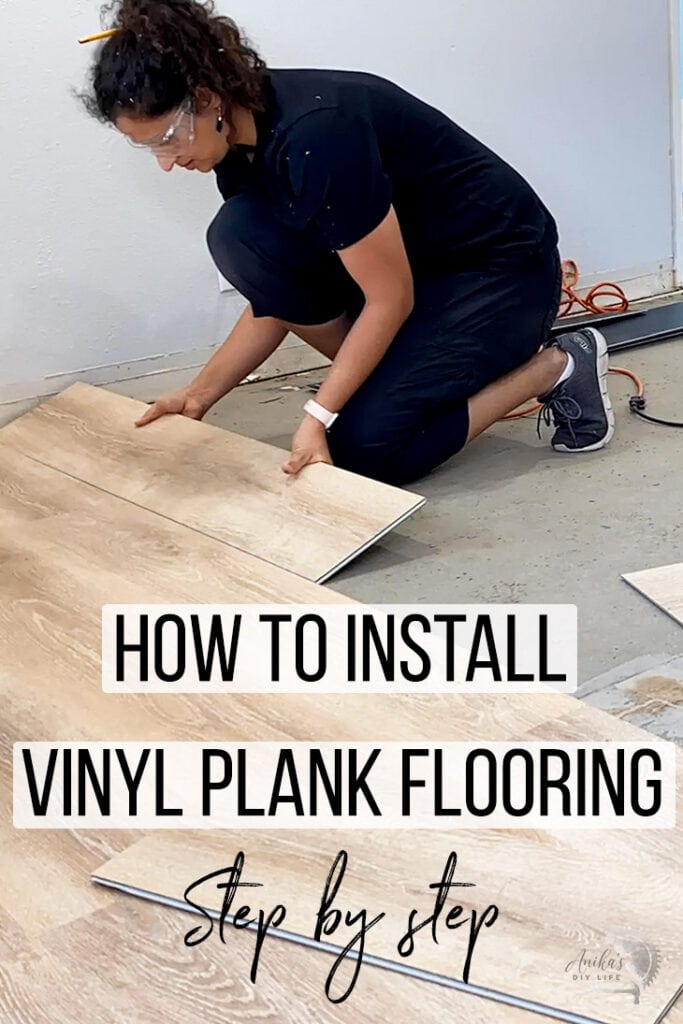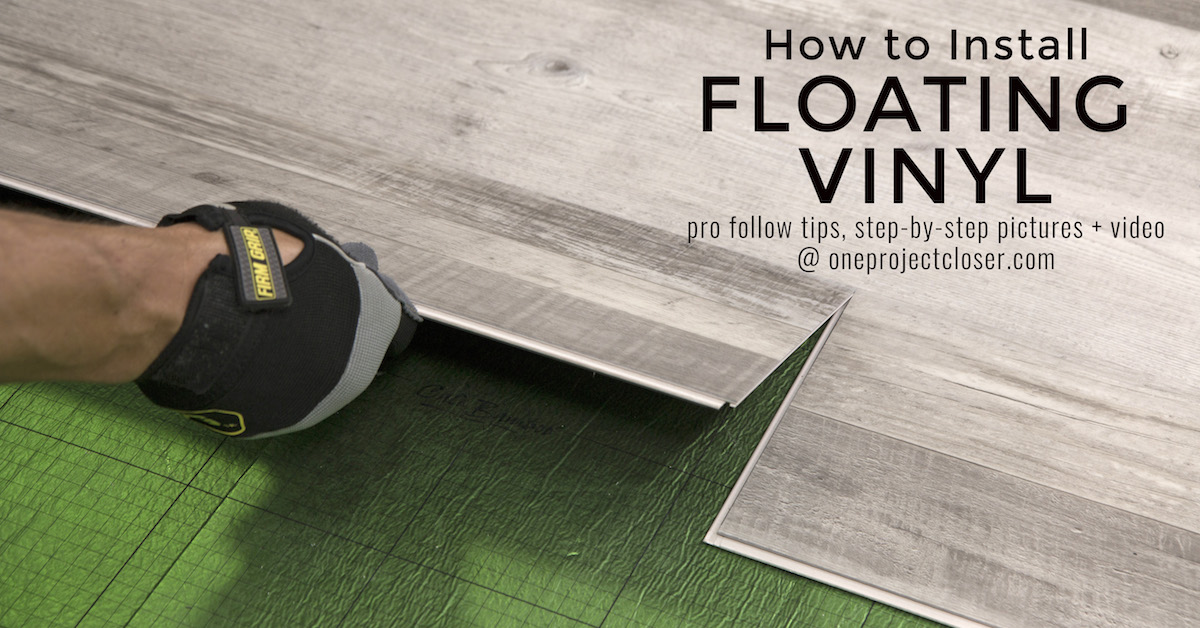Ever wondered if you can layer vinyl flooring on top of existing vinyl? It’s a question that arises frequently, fueled by the desire to revamp a room without the hassle of removing old flooring. While the prospect of quick renovation sounds appealing, the reality is more nuanced. Layering vinyl flooring isn’t always as straightforward as it might seem, and there are crucial factors to consider before taking the plunge.

Image: www.anikasdiylife.com
This article will delve into the intricacies of installing vinyl flooring over vinyl flooring. We’ll explore the advantages and drawbacks, examine the different types of vinyl flooring, and provide valuable tips for a successful and long-lasting outcome. Whether you’re a DIY enthusiast or seeking guidance from a professional, understanding the complexities of this installation approach will equip you with the knowledge to make an informed decision.
Delving into the Layering Dilemma
The allure of installing vinyl flooring over vinyl flooring lies in its potential to save time and effort. Removing existing flooring, particularly if it’s glued down, can be a laborious and messy process. So, the idea of laying new vinyl directly on top seems like a shortcut, especially for those with limited renovation experience. However, before you grab your tools and dive into the project, it’s crucial to weigh the potential benefits against the potential drawbacks.
Advantages of Layering Vinyl Flooring
There are several compelling reasons why some homeowners choose to install new vinyl flooring over existing vinyl:
- Time and Cost Savings: Layering vinyl can significantly reduce the time and effort required compared to removing existing flooring. This can translate into lower labor costs and a faster turnaround time for your renovation project.
- Minimal Disruption: Installing new vinyl over existing flooring minimizes dust, debris, and noise, creating a less disruptive renovation process.
- Convenient Solution: In situations where removing existing flooring is impossible or impractical, layering vinyl offers a convenient alternative.
Disadvantages of Layering Vinyl Flooring
While layering vinyl flooring has its advantages, several drawbacks need careful consideration:
- Increased Thickness: Layering vinyl flooring will increase the overall thickness of the floor, potentially affecting door clearances, moldings, and transitions to other flooring surfaces.
- Potential Unevenness: If the existing vinyl floor isn’t perfectly level, the new vinyl layer may reflect imperfections, leading to an uneven surface.
- Limited Durability: Layering can compromise the structural integrity of the floor and may reduce the lifespan of both layers of vinyl.
- Potential for Moisture Issues: In areas prone to moisture, layering vinyl can trap moisture, leading to potential mold and mildew growth.
- Warranty Concerns: Manufacturers’ warranties for vinyl flooring may be voided if the product is installed over existing flooring, so check the warranty terms before proceeding.

Image: www.oneprojectcloser.com
Understanding Vinyl Flooring Types
Vinyl flooring has evolved dramatically, offering various options to suit different needs and aesthetics. Understanding the different types of vinyl flooring is crucial when deciding whether layering is a suitable option.
Sheet vinyl is a single piece of vinyl that’s typically glued down to the subfloor, while luxury vinyl tile (LVP) and luxury vinyl plank (LVP) are individual tiles or planks that can be glued down, clicked together, or installed over an underlayment.
Layering Considerations for Different Vinyl Types
Here’s a breakdown of the layering suitability for common vinyl flooring types:
Layering Sheet Vinyl Over Existing Sheet Vinyl
Layering sheet vinyl over existing sheet vinyl is generally not recommended. The adhesive used to install sheet vinyl creates a strong bond to the subfloor, making it challenging to remove without significant damage. Furthermore, the combined thickness of two layers of sheet vinyl can be excessive, leading to unevenness and potential for buckling.
Layering LVP/LVP Over Existing Sheet Vinyl
Layering LVP/LVP over existing sheet vinyl is possible, but it requires careful consideration. The existing sheet vinyl must be structurally sound, smooth, and free from any raised edges or imperfections. A moisture-resistant underlayment is highly recommended to prevent moisture issues and provide added cushioning. Seek professional advice if unsure about the feasibility of this approach.
Layering LVP/LVP Over Existing LVP/LVP
Layering LVP/LVP over existing LVP/LVP is generally not advisable. The clicks and grooves designed for interlocking LVP/LVP tiles or planks can cause instability and uneven surfaces when layered over existing LVP/LVP. This approach is more likely to lead to creaking sounds and potential damage to both layers.
Factors Influencing Layering Decision
Beyond the specific types of vinyl flooring, several additional factors impact the feasibility and success of layering vinyl flooring:
- Floor Condition: The condition of the existing vinyl flooring is critical. It must be smooth, even, and free from any significant cracks, gaps, or loose areas. Any imperfections will be amplified by the new layer.
- Subfloor Condition: The subfloor must be structurally sound and level to support the added weight and stress of the layered flooring. If the subfloor is uneven, it may need to be repaired or leveled before installing new vinyl.
- Moisture Levels: Moisture can be a significant issue when layering vinyl flooring. Ensure the subfloor is dry and free from any signs of moisture damage. A vapor barrier or moisture-resistant underlayment is essential in areas prone to moisture.
- Floor Thickness: The overall thickness of the layered flooring should be considered, especially if it affects door clearances, moldings, and transitions to other floor surfaces. Ensure the chosen vinyl flooring is thin enough to accommodate the existing floor height.
- Installation Expertise: Proper installation is crucial for the success of layering vinyl flooring. It’s best to engage a professional installer with experience in this type of project, especially if you’re unfamiliar with vinyl flooring installation.
Alternatives to Layering Vinyl Flooring
If you’re considering layering vinyl flooring but are concerned about potential complications, there are several alternatives worth exploring:
- Remove Existing Flooring: While time-consuming and potentially messy, removing existing vinyl flooring ensures a solid foundation for new flooring installation. This approach offers the most reliable and long-lasting solution.
- Use a Different Flooring Type: If layering vinyl isn’t feasible, consider alternative flooring options, such as laminate, wood, or tile, which may be more compatible with your existing flooring and subfloor.
- Choose a Thinner Vinyl Flooring: If you’re adamant about layering, select a thinner vinyl flooring option to minimize the overall thickness and potential for unevenness.
- Consider a Floor Leveling Compound: If the existing vinyl floor has minor imperfections, a floor leveling compound can create a smoother surface for the new vinyl.
Can Vinyl Flooring Be Installed Over Vinyl Flooring
Conclusion
Layering vinyl flooring over vinyl flooring can be a tempting shortcut for renovation projects, offering potential time and cost savings. However, it’s important to understand the potential drawbacks and factors influencing the feasibility and success of this approach. Before embarking on this project, carefully assess the condition of your existing flooring and subfloor, consider the specific vinyl flooring types involved, and weigh the potential benefits against the risks. Seek professional advice if unsure about the suitability of layering vinyl flooring, and explore alternative flooring options if necessary. A well-informed decision will ensure a satisfying and long-lasting renovation for your home.





